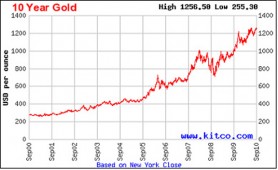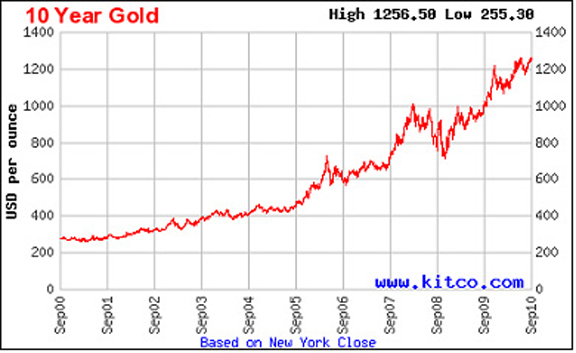Conclusion
Introduction
Last week, I diverted from a brief review on the gold-mining sector begun a fortnight ago to comment on the unfortunate death of Mr Gordon Maxwell, the small-time promoter who died by drowning as he tried to escape from the police while awaiting the posting of bail of $30,000. He was on a charge of tax evasion and took Leona Helmsley’s famous statement that only the poor pay taxes to the absolute ultimate.

The modest economic recovery witnessed in these countries is met with the fear of a double dip, that the recovery was more like a W than a U, a fear that is shared by many, but apparently not by the Organisation of Economic Co-operation and Development (OECD). The OECD now concedes that global economic recovery is slowing at a faster rate than expected and that the growth in the Group of Seven countries – Canada, France, Germany, Britain, Italy, Japan, and the US – is now expected to be 1.5% on an annualised basis in the second half of 2010, down from its May 2010 forecast of 1.75%. However, the group in its latest assessment has said that the loss of momentum in the recovery was “temporary” and that a double-dip recession remains unlikely.
The new power houses
Note of course that the power, clout and influence which those countries once wielded has declined rapidly in the past five years and the real economic powerhouses are China and India, and to a significant but lesser extent Brazil and Russia. Indeed, the Chinese dragon has just overtaken Japan as the Number Two economy in the world. India and China are the leading consumers of gold in the world while China has now overtaken South Africa in the league of gold producers in the world. China is now so flush with US dollar reserves and growing trade surpluses that it now suffers from one of the rarest problems facing any country – it is too rich and only getting richer. The world may soon be running out of superlatives to describe China’s economic performance and there are few signs that it will slow any time soon.
As their economies continue to surge ahead and their increasingly well-off population demand greater comforts and display luxury and ostentation in the cars they drive and the clothing and jewellery they wear, the Chinese and Indians are expected to demand more gold as a consumer product. Put the troubles of the OECD in the mixer and add a dash of consumerism in India and China which make up for 40% of the world population, and you would expect gold prices which have doubled since 2006 to remain high, and if you want to be bearish, even increase. Apart from the effect of consumerism, the rise in the gold price seems entirely justified when compared with the performance of the Dow Jones Industrial Average and the FTSE 100 which declined by 4% and 5.4 % respectively during the same period.
The Economist Intelligence Unit again

The history of commodities, whether real or imagined – such as the South Sea Bubble or the Tulip Bubble – is that any sharp increases in price have an artificiality about them. And those who think that such phenomena are explainable by market under-development of the past would have the devil’s job to rationalise the real-estate bubble, the stock market bubbles, and the dot com bubble of the recent and very recent past. It is all, as the economists would tell you, about fundamentals.
And the fundamentals in favour of gold prices are generally positive. Unless the causes of the fears about the international economy are removed, gold prices are expected to remain high. Some commodity experts expect that the price of gold would fall if inflation falls or becomes negative, a counter-intuitive position given that historically the price of gold has risen in line with inflation. So why is the Guyana government taking such a casual approach to the gold mining sector?
Balancing concerns and contribution
Both anecdotal and empirical evidence suggest that there are legitimate concerns about the negative impact of mining on the environment and communities in which mining takes place. The evidence is also compelling about the contribution of the industry to the local communities and the national economy. During the four years 2006-2009:
a) gold contributed 6.0% of Gross Domestic Product at constant prices;
b) gold contributed 25.6% of the export revenues of the country, and in 2009, 36.7%, in both cases higher than any other sector; and
c) the revenue generated by the regulatory agency surpassed that of any other agency.
The industry employs directly several thousand persons from depressed coastal communities who would otherwise find it difficult to gain employment on the coast, and thousands more indirectly. The industry is more than a stand-alone sector and has backward and forward linkages with a range of support services including metal fabrication, machine construction and repair, transportation, carpentry, plumbing, welding, pipefitting, and blasting.
The sector is the principal employer in many hinterland communities including Amerindian communities that are themselves engaging competitively in gold mining. Entire communities that owe their existence to the industry include not only traditionally mixed communities such as Mahdia and Bartica, but Amerindian communities such as Arau, Jawalla, Paramakatoi, Aurora, etc.
The larger mining companies and the Guyana Geology and Mines Commission (GGMC), through resources provided by the industry, are responsible for the construction and maintenance of airstrips and hundreds of kilometres of hinterland roads, providing access to those communities and their access to the coastland. In the process, these communities have been provided with support services such as education, health and other social facilities.
The challenge for the mining industry and the government is to balance legitimate concerns for the environment generally and the forest resources in particular with continued utilisation of the mining potential of the country. As good as it is, the LCDS cannot in the short term provide the jobs that will be lost if mining is miniaturised to meet the conditions under which the LCDS will be forced to operate. Gold prices will certainly fall at some time. The prediction is that the price may fall to around US$800 per ounce. Even at that price, the industry will be profitable and contribute significantly to the national coffers.
Conclusion
In the meanwhile the industry and the country should capitalise on the price bonanza. To do so, the industry, its representatives and the government need to fill in the huge data gaps that render policy formulation and decision virtual guess work. The rewards would be greatly improved if decisions about the industry were made with adequate consultation and on the basis of adequate information about key variables such as gold reserves, the acreage under active mining operations, the number of persons employed in the sector, the quantities mined and declared, the danger of driving the sector underground by over-regulation, illegal cross-border mining activities, etc.
As only a small player in the international scheme of things, Guyana can do nothing about the predictions of the EIU other than hope they materialise later rather than sooner. But let us not sacrifice the small and medium gold-mining operations to the politically charged and used LCDS, the money from which will not be spread around as it is in the mining sector.





